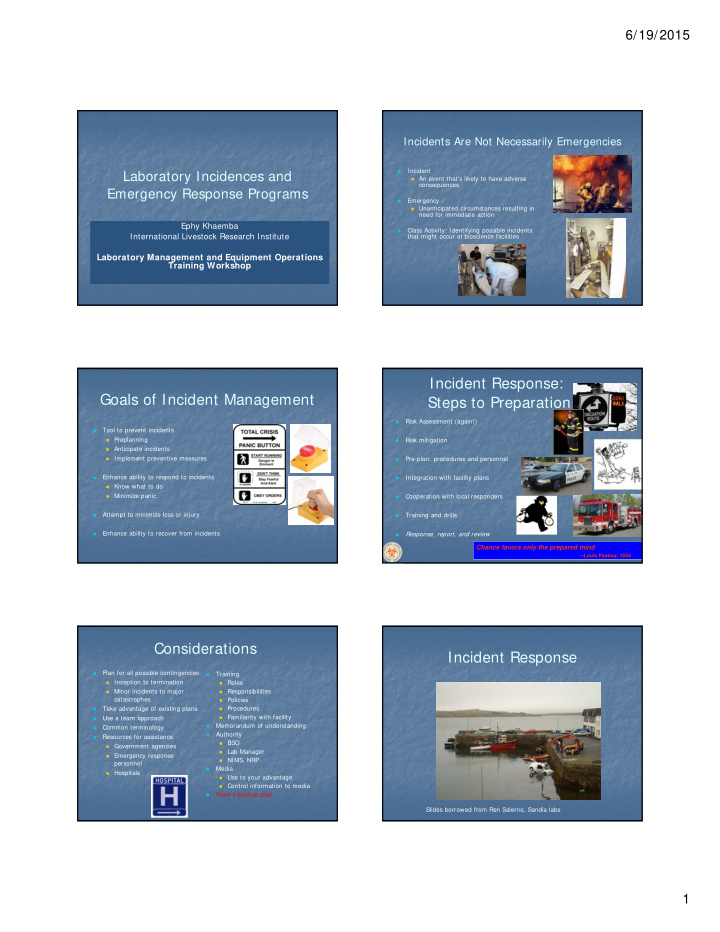



6/19/2015 Incidents Are Not Necessarily Emergencies � Incident Laboratory Incidences and An event that’s likely to have adverse � consequences Emergency Response Programs Emergency � � Unanticipated circumstances resulting in need for immediate action Ephy Khaemba Class Activity: Identifying possible incidents � International Livestock Research Institute that might occur at bioscience facilities Laboratory Management and Equipment Operations Training Workshop Incident Response: Goals of Incident Management Steps to Preparation � Risk Assessment (again!) Tool to prevent incidents � Preplanning � � Risk mitigation Anticipate incidents � Implement preventive measures � � Pre-plan: procedures and personnel Enhance ability to respond to incidents � � Integration with facility plans Know what to do � Minimize panic Cooperation with local responders � � � Attempt to minimize loss or injury Training and drills � � Enhance ability to recover from incidents Response, report, and review � Chance favors only the prepared mind --Louis Pasteur, 1854 Considerations Incident Response Plan for all possible contingencies � Training � Inception to termination � � Roles Minor incidents to major Responsibilities � � catastrophes Policies � � Take advantage of existing plans � Procedures Familiarity with facility � Use a team approach � Memorandum of understanding � � Common terminology � Authority � Resources for assistance BSO � � Government agencies Lab Manager � � Emergency response � NIMS, NRP personnel � Media Hospitals � Use to your advantage � Control information to media � � Have a backup plan Slides borrowed from Ren Salerno, Sandia labs 1
6/19/2015 Don’t make it worse! 2
6/19/2015 Emergency Responses Learn from past incidents to improve your response SOPs KEY CONCEPTS � Pre-Planning Front line response � Establishing Procedures begins at the local � Practicing Established Procedures level � Risk Mitigation � Training � Procedural Review Risk Mitigation: Emergency Emergency Pre-Planning Planning � Determine the level of required preparation through the risk assessment Utilizing the results of � The risk assessment indicates the breadth of hazardous materials that could be spilled or the risk assessment, released into the environment determine the critical � Establish the response parameters. points where an emergency may � Determine who is required to respond and when and how they must respond occur 3
6/19/2015 Emergency Response Establishing Procedures � Develop plan before the emergency � Enlist the input of � lab manager/director, � Include all appropriate parties in planning � local emergency response team, � representation from interested parties � Inform and involve community-based responders � Use your Risk Assessment to mitigate the highest probability � Conduct drills & after-incident reviews Review literature, best practices � � Emergency Response Integrate throughout the Personnel Involved in a Organization Potential Exposure � Personnel Involved in a Potential Exposure � Cover all contingencies Should report to a health clinic as soon as � Medical Emergencies possible � First aid � Spills � Prophylaxis � Breaches in containment � The Lab Chief should be contacted immediately, � Physical events (fire, utility outage, …) or if unavailable, the lab manager � Natural events (storms, earthquakes, …) The Lab Chief should then contact safety � � Integrate throughout the Organization personnel or the Biosafety Committee Training Procedural Review � Train and re-train Annually and after every “event” Repetition creates a stronger � Ask yourself training memory = Reaffirmation Provides another opportunity to refine procedures � � Where did the “Plan go wrong”? Establish a regular drill schedule � � What went as planned? Vary HOW training is done � � What can be enhanced? � Where is training lacking? 4
6/19/2015 Questions?? 5
Recommend
More recommend